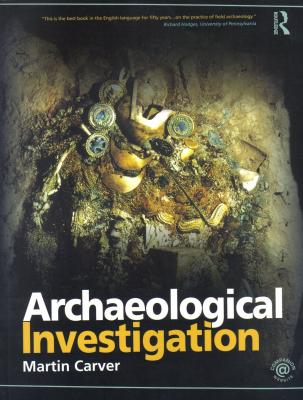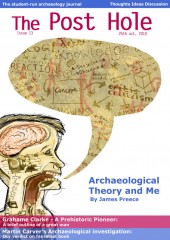Archaeological Investigation, published in 2009, is the most recent publication of Martin Carver, the much loved Antiquity editor and Sutton Hoo excavator. This paper is a review of this exciting new read.
After initially opening the book the first place I found was the Chapter listing and this seems to be one of the best places to start my review of this book. The navigation structure is simple and intuitive. Each chapter has a name that is self-explanatory in its function and role within the book that allows for easy navigation and selection of relevant chapters. Throughout the book there is a consistent use of figures, illustrations, graphs and photographs of a consistent high quality and relevance to the text that they support.
This inclusion of figures and visual references is not however without some problems and teething issues; whilst they do not detract from the text, it could still be an area for improvement from the reader's point of view. This is especially true if the reader is unfamiliar with some aspects of archaeology as some figures have only a subheading but no concrete explanation. Some rogue photos do appear to be labelled as, for example, "showing medieval and prehistoric features" yet no definition or clues are given as to what period each distinguishable feature pertains to. These are only minor issues and with reference to the body text are quite easily be deciphered, but with something that really draws the eye, such as a photograph, sometimes a more in-depth caption would be appreciated. There are a generous amount of photographs provided in the middle section of the book, all of which are in colour. Unfortunately the inclusion of this section does truncate a sentence forcing the reader to flip past several pages to finish what they were reading. Whilst this is an irritation, it can hardly be placed at Carver's feet and does not affect the enjoyment I got from this book.
Enjoyment is very much the operative word. Whilst this book is highly informative and full of a careers worth of knowledge, it is also to be highly commended on the enjoyment that it offers its reader. Each chapter is framed in its context by a wide discussion of all pertinent points; excavation delves into discussions of health and safety, and as well as being enjoyable provides much practical knowledge for the archaeologists' tool-belt. Martin Carver is a highly charismatic writer with a style that is both welcoming and friendly. His writing is very relaxed, and at no point does he ever seem condescending. The reader is instead pleasantly informed by Carver the explanation of any jargon and complex issues being broken down. There is an infectious charm and honest approach to the nature of this book. The honesty is appreciated: Carver himself is the first to highlight that this book has been written from his own experiences and view points, and that inevitably this is the way that Martin Carver does things, with an awareness and openness about other schools of thought.
Throughout his colourful, entertaining and informative narration, Martin Carver offers further reading at many opportunities; both at the ends of chapters and in the text itself where he offers comments on their use and usefulness to a reader from his own opinion. To a new archaeology student, these are very welcome and obviously helpful if a topic particularly catches the attention and imagination.
This is not to say that the writing style is perfect or that it could not conceivably be improved if we were picky. Carver always has a point; however, some aspects of his writing can seem a little bit verbose in style and initially an effort to read through. This is mitigated when the informative point is reached but it is temptin g to ponder if this point could be made in a more succinct way. Upon reflection, to change the writing style in such a dramatic way would damage something that the book has heavily in its favour: character. Whilst reading, it does feel as if Martin Carver is there with you and the whole book is a charming conversation with him personally. This is one of the few books I have read where it feels as if the book itself lavishes you with personal attention.
Admittedly, some paragraphs could be broken up more. In one or two places there are some sentences that do not seem to flow from one to the next as smoothly as perhaps would be liked, yet given the scope and the context of this book these are easily forgiven and forgotten.
Considering the entirety of the book, its scope and content, its character and goal it is a very good read and is not only very informative but very entertaining. I really cannot give the book's character enough credit, even in the chapters where the subject would otherwise feel tedious, the charisma loaded into these pages easily carries the book and makes the reader continue reading. It is loaded with individual flavour, charm, honesty and a career's worth of accumulated knowledge and anecdotes. Every chapter read feels rewarding in itself and it is a joy to read, not only academically, but also because it is a good book on a subject that we all love.
This book is a great tool; it is a must-have for any archaeology reader's bookshelf, both for reference and general interest. I would say more, but the part on artefacts in the Assemblage chapter is calling me, and that is really the highest recommendation that I can give.





